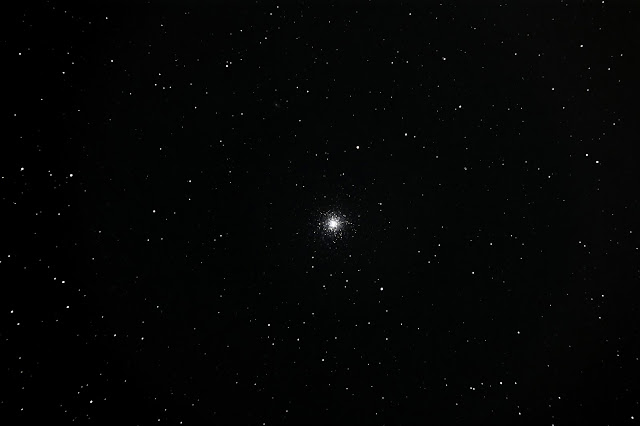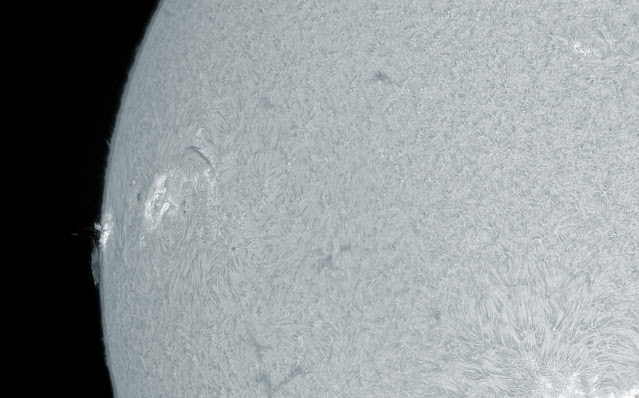Slowly Learning
Evening skies remained beautifully clear following my afternoon solar imaging session on April 12th. After sunset observing conditions were ideal with low humidity, no dew, no wind, no moonlight, and temperatures in the 60's! I set up my 130 mm Stellarvue refractor and Nikon Z6 2 camera for another attempt at astrophotography. As twilight faded I took a quick 2-second exposure of Venus near the Pleiades with the Nikon mounted on a fixed tripod. ISO was set at 1600 and the f/2.8, 24-70 mm lens was set to 70 mm. Venus was closer to the Pleiades a few days earlier, but this pairing was still nice.
With the camera on the telescope I captured dark frames and flat fields in order to improve image quality. Dark frames are easy to get - just cover the telescope aperture with a lens cap and capture what the camera records when no light falls on the detector. Ideally, when no light falls on the detector, it should record zero for every pixel across the field of view. A real detector, however, does not read zero across the field. If the dark frame has the same exposure time as an actual image of a celestial object, then the non-zero dark frame detector response can be subtracted from the image to leave a result not degraded by false signal.
A flat field image is the image of a uniform light source across the field of view. Ideally, the camera detector should record an image of a uniform light source that is absolutely uniform across the field of view. Unfortunately, a real camera's response will not be absolutely uniform because pixels vary somewhat in sensitivity, or because some dust or dirt on the detector blocks pixels, or because the optical system doesn't produce uniform light across the detector. My Nikon exhibits significant vignetting - images are brighter in the center and darker at the edges. So I need to record a flat field image to correct real images from non-uniform detector response.
Producing a uniform light source for the telescope in my backyard is inconvenient. For this session I covered the telescope aperture with either a single sheet of white paper, or a white cloth. I then illuminated the paper or cloth with an LED light held at some distance. This method was partially successful, a definite improvement over no flats at all, but it wasn't perfect. I still had to sacrifice dim image detail in order to make sky background uniformly dark.
Here are some results from April 12th. First is an image of the edge-on galaxy NGC 4565 in the constellation Coma Berenices made by stacking eighteen, 10-second exposures with ISO set at 6400.
Click on this image to view it at full size and notice the small smudge below galaxy 4565 at the end of a curved string of 5 stars. This smudge is spiral galaxy NGC 4562. If you look closely at the full size image, you might just make out a tiny grey fuzzy object about half of 4565's width distant on the left side of 4565. This is a 14.6 magnitude spiral galaxy, IC3546.
NGC 2903, a barred spiral galaxy in Leo, is shown in the next image made by stacking nine, 15-second exposures at ISO 25600. Once again, the full-sized image shows the most detail and reveals the bar and some spiral structure.
The next picture is the Whirlpool Galaxy M51 in the constellation Canes Venatici made by stacking eight, 15-second exposures at ISO 25600.
The four previous galaxy pictures were made without a Barlow lens. All of them beg for greater magnification and longer exposures. The image scale is also too small to display the full amount of fine detail present in the best images of these galaxies. Nevertheless, I was pleased with the improved image quality compared with my last attempt on March 4th!
Another magnificent clear, mild, moonless night occurred on April 18th. On the 18th I tried three new things. First, I lowered ISO setting to 1600 to see if image noise could be reduced. Second, I increased exposure times. Third, I tried a few images with a 2X Barlow lens.
The next two images are the galaxy pair M81 and M82 in Ursa Major. The first image, from April 12th, was made by stacking twenty, 8-second exposures at ISO 12800. The second image, from April 18th, was made by stacking twenty, 30-second exposures at ISO 1600.
There doesn't seem to be much difference between the two previous images. The longer exposure at lower ISO in the bottom image didn't reveal more detail. Perhaps a longer exposure at higher ISO would have revealed more.
What about higher magnification? The next two images of globular cluster M13 in the constellation Hercules show the effect of adding a 2X Barlow lens. The first picture, from April 12th, was made with no Barlow by stacking nine, 15-second exposures at ISO 6400. The second picture, from April 18th, was made with a 2X Barlow by stacking twenty, 30-second exposures at ISO 1600.
The second magnified M13 image does show more stars and begins to display some orange/yellow color of older stars. There's not enough magnification to resolve individual stars in the cluster's center, however. I'd like to try longer exposure time on this in the future.
Finally, galaxy M108 and planetary nebula M97 in Ursa Major are close enough to form a beautiful pair in my camera's field of view. The next image was constructed with no Barlow lens from twenty, 30-second exposures with ISO at 1600. The colors of planetary nebula M97 show up well, but the galaxy lacks detail. These objects deserve more magnification.
I installed a 2X Barlow lens and took another twenty, 30-second exposures at ISO 1600 to get a magnified view. Unfortunately, as the next image shows, the result is dimmer because object brightness was spread over a larger area.
Once again, I'd like to return to this pair and double or triple exposure time.
It looks like on a given night I'll have to limit the number of different objects I photograph to spend more time exposing a selected few. Unfortunately, there's no way to avoid an intense, glaring light shining directly on my observing site from a neighbor's window. This light will sometimes get turned off after midnight, but often it's left on all night long! Anyway, it will be at least another few weeks with clouds and moonlight before conditions will allow another astrophotography attempt.











